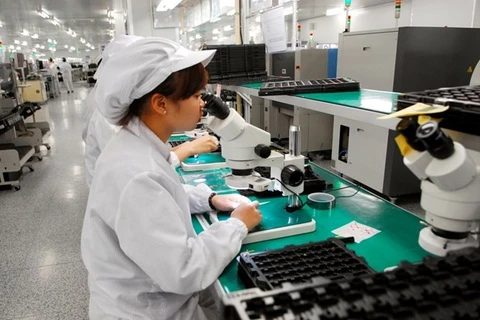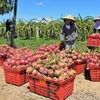
Hanoi (VNA) – HSBC has revised its forecast for Vietnam’s gross domestic product growth for this year to 6.5%, up from the previous projection of 6%, following the country’s better-than-expected performance in the first half, according to its latest report, “Vietnam at a glance: Bring it all back”.
Vietnam ended the second quarter with a massive upside surprise to its GDP growth, which accelerated to 6.9% year-on-year, well above market expectations of 6%, HSBC experts said.
Beyond headline numbers, its recovery has started to show signs of broadening, they noted.
HSBC's report highlighted the manufacturing sector as the most surprising, growing by 10% year-on-year. This was reflected in strong export growth in the second quarter, which reached 15% year-on-year. While the recovery was mainly led by the electronics sector, other industries also began to show signs of a rebound.
Moreover, the business sentiment among the manufacturers has visibly improved. The Purchasing Managers' Index (PMI) for June surged to 54.7, the highest in two years.
While near-term trade has started to take off, long-term FDI prospects remain a bright spot.
Despite moderating from its peak in 2017, new foreign direct investment (FDI) continues to pour into the Vietnamese market. Undoubtedly, manufacturing accounts for the lion’s share, with new registered FDI reaching close to 10 billion USD in the first half of the year.
While investments from mainland China and the Republic of Korea are often highlighted, investment from ASEAN peers continues to be strong, particularly from Singapore. Singapore tops the list as the country’s largest FDI provider.

In addition, trade and tourism-related services have maintained a positive trajectory. In the first half alone, Vietnam attracted over 8.8 million visitors, surpassing the total logged in 2019.
While Vietnam is on track to reach its annual goal of welcoming 17-18 million tourists in 2024, there is still room for further improvement, including an expansion on the visa exemption list, HSBC experts noted.
However, as of mid-2024, retail revenue growth had yet to fully recover to pre-pandemic levels.
Based on HSBC estimates, there is still a sizeable 10% gap below what the pre-pandemic trend would suggest. But as the external recovery continues to broaden, the spillover effect should ultimately translate into the domestic sector, but this is likely to be stronger in the fourth quarter.
The Vietnamese Government continues with policies in support of the domestic economy, with the National Assembly recently agreeing to extend the VAT reduction from 10% to 8% until the end of this year and reduce certain fees for specific industries. These measures are expected to support the economy in the coming period.

Headline inflation rose 0.2% month-on-month in June, translating into a still-high year-on-year figure of 4.3%. While monthly oil prices dropped, this fall was more than offset by a rise in pork prices, due to the ongoing African swine fever (ASF) since early this year.
HSBC forecasts inflation to moderate to a little above 3% in the second half of this year and is likely to bring average inflation for the whole year to 3.6%.
Given the better-than-expected outcomes during the first half of the year, HSBC experts are upgrading their yearly GDP growth forecast to 6.5% for 2024. This means that the country is likely to be the fastest-growing economy in ASEAN, a spot that it lost to regional peers Malaysia and the Philippines in 2022 and 2023, respectively.
They also maintain their view that the State Bank of Vietnam (SBV) is likely to keep its policy rate steady at 4.50% this year despite lingering foreign exchange concerns that may prompt the SBV to hike rates./.






















